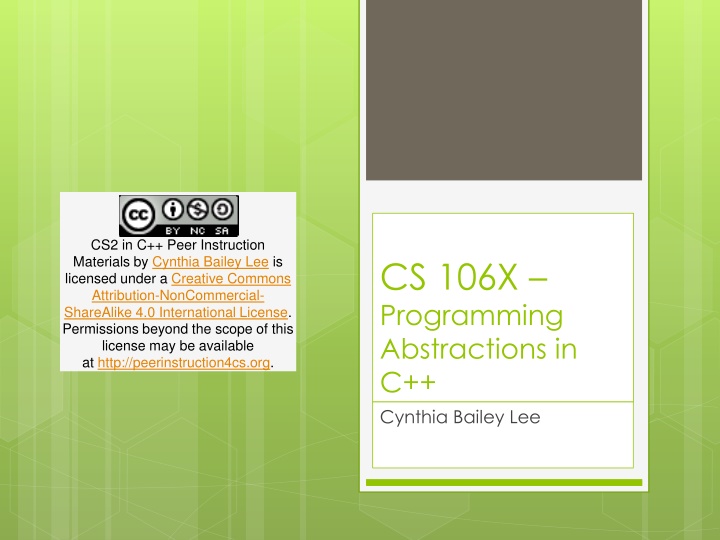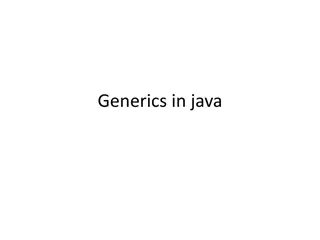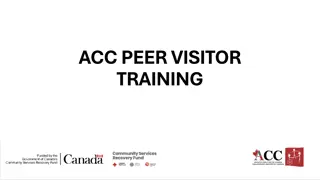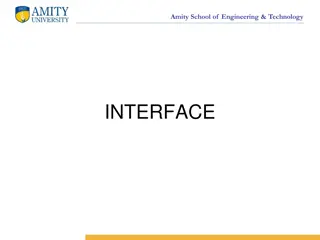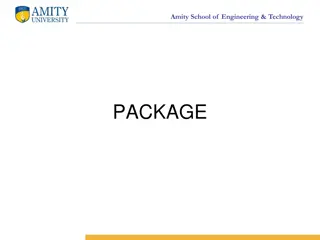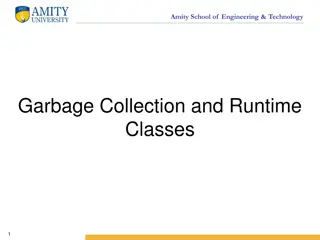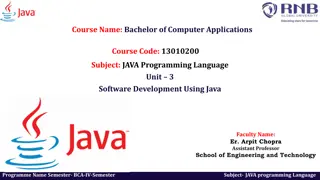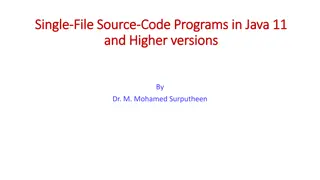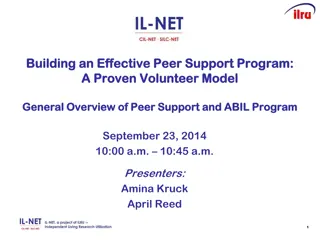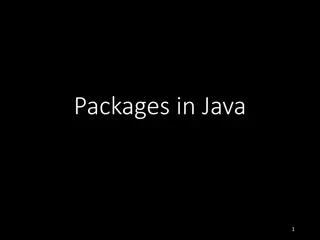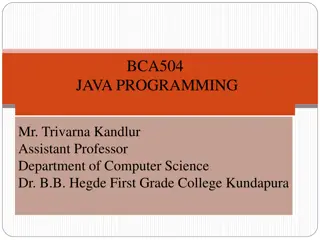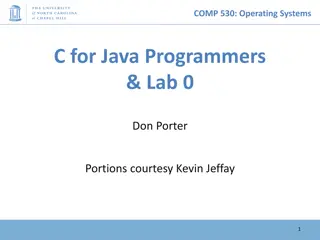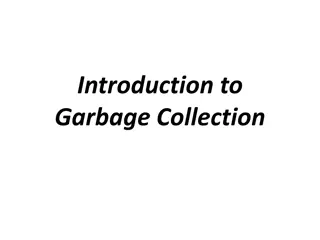C++ Programming Abstractions: Peer Instruction for Java Programmers
"Explore C++ concepts from a Java programmer's perspective, emphasizing good design principles like decomposition and readability. Delve into coding examples, such as clearing a chess board for a Queen safety program, discussing off-by-one errors, pass by reference feature, and decision making between board printing methods."
Download Presentation

Please find below an Image/Link to download the presentation.
The content on the website is provided AS IS for your information and personal use only. It may not be sold, licensed, or shared on other websites without obtaining consent from the author.If you encounter any issues during the download, it is possible that the publisher has removed the file from their server.
You are allowed to download the files provided on this website for personal or commercial use, subject to the condition that they are used lawfully. All files are the property of their respective owners.
The content on the website is provided AS IS for your information and personal use only. It may not be sold, licensed, or shared on other websites without obtaining consent from the author.
E N D
Presentation Transcript
Creative Commons License CS2 in C++ Peer Instruction Materials by Cynthia Bailey Lee is licensed under a Creative Commons Attribution-NonCommercial- ShareAlike 4.0 International License. Permissions beyond the scope of this license may be available at http://peerinstruction4cs.org. CS 106X Programming Abstractions in C++ Cynthia Bailey Lee
2 Today s Topics 1. Introduce the C++ language from the Java programmer s perspective (But it s ok if you are not a Java programmer) 2. Foster introspection about good design Decomposition, reuse, simplification, readability Serve as an orientation to our expectations for your programming assignments
Todays main example: Queen safety
Queen safety (BUG) // (includes omitted) static void clearBoard(Grid<bool> board); The for loops have an off-by-one error on the edges of the grid Board is declared but not instantiated The board in main() is not updated The code is inefficient All/ none/ more than one of the above A. int main(){ Grid<bool> board(8,8); /* note that clearing here is not * strictly necessary */ clearBoard(board); // more code to come return 0; } B. C. static void clearBoard(Grid<bool> board){ for (int i=0; i<board.numRows(); i++){ for (int j=0; j<board.numCols(); j++){ board[i][j] = false; } } } D. E.
C++ feature: pass by reference // (includes omitted) static void clearBoard(Grid<bool> board); int main(){ Grid<bool> board(8,8); /* note that clearing here is not * strictly necessary */ clearBoard(board); // more code to come return 0; } static void clearBoard(Grid<bool>& board){ for (int i=0; i<board.numRows(); i++){ for (int j=0; j<board.numCols(); j++){ board[i][j] = false; } } }
Now consider a function printBoard Loops over the Grid object and prints all the contents to cout Unlike clearBoard, it does not modify the board ( read only )
Which is better? static void printBoard(Grid<bool>& board){ for (int i=0; i<board.numRows(); i++){ for (int j=0; j<board.numCols(); j++){ cout << board[i][j]; } cout << endl; } } (A) static void printBoard(Grid<bool> board){ for (int i=0; i<board.numRows(); i++){ for (int j=0; j<board.numCols(); j++){ cout << board[i][j]; } cout << endl; } } (B) (C) Other/none/more than one
Which is better? static void printBoard(Grid<bool>& board){ for (int i=0; i<board.numRows(); i++){ for (int j=0; j<board.numCols(); j++){ cout << board[i][j]; } cout << endl; } } ANSWER: Hard to say! Efficiency vs. safety is a classic tension in CS. (A) static void printBoard(Grid<bool> board){ for (int i=0; i<board.numRows(); i++){ for (int j=0; j<board.numCols(); j++){ cout << board[i][j]; } cout << endl; } } (B) A better way we ll learn later: const (C) Other/none/more than one
Handy loop idiom: iterating over neighbors in a Grid static bool isSafe(Grid<bool>& board, int row, int col) { for (int drow = -1; drow <= 1; drow++) { for (int dcol = -1; dcol <= 1; dcol++) { if (!isDirectionSafe(board, row, col, drow, dcol)) { return false; } } } return true; } These nested for loops generate all the pairs in the cross product {-1,0,1} x {-1,0,1}, and we can add these as offsets to a (row,col) coordinate to generate all the neighbors (note: often want to test for and exclude the (0,0) offset, which is our self)
Stanford library random number utilities static void placeRandomQueens(Grid<bool>& board) { int numQueensPlaced = 0; while (numQueensPlaced < kNumQueens) { int row = randomInteger(0, board.numRows() - 1); int col = randomInteger(0, board.numCols() - 1); if (!board[row][col]) { board[row][col] = true; numQueensPlaced++; } } } There are other functions in addition to randomInteger, they are pretty self-explanatory. See reference web page.
Handy loop idiom: edge detection example /* Returns true if the pixel at row,col is on an edge. */ static bool isEdge(Grid<Pixel>& board, int row, int col, int threshold) { for (int drow=row-1; drow<=row+1; drow++) { for (int dcol=col-1; dcol<=col+1; dcol++) { if (difference(board[row,col],board[drow,dcol]) > threshold) { return true; } } } return false; }
ADTs Programming language independent models of common containers They encompass not only the nature of the data, but ways of accessing it They form a rich vocabulary of nouns and verbs, often drawing on analogies to make their use intuitive, and to give code written in them a certain literary quality
ADTs implemented in the Stanford Library Vector Grid Graph Map (and HashMap) Set (and HashSet) Map PriorityQueue Queue
ADT: Grid queensafety.cpp #include <iostream> #include "console.h" #include "grid.h" using namespace std; static void clearBoard(Grid<bool>& board); int main(){ Grid<bool> board(8,8); clearBoard(board); // more code to come return 0; } static void clearBoard(Grid<bool>& board){ for (int i=0; i<board.numRows(); i++){ for (int j=0; j<board.numCols(); j++){ board[i][j] = false; } } }
